Why I Refused to Invest in Chronobank
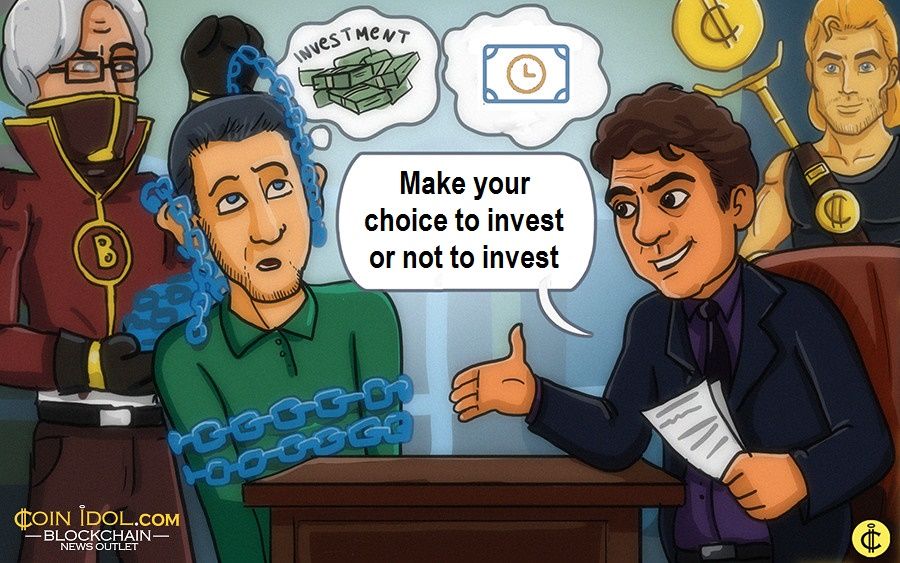
My name is Alexey Anthonov and I am a private investor in Blockchain projects, as well as a Blockchain tech evangelist in Russia. I’m the director of BCFoundation, the first organisation in Russia to support the development of Blockchain technology. I truly adore different tech innovation startups that can change any part of business, government or society.
Thanks to a massive amount of advertisement and the Russian background of this Australian project, I noticed and became interested in the Chronobank project.
First I decided to understand it, if I’m buying Labour Hours tokens and intend to use them as they were designed – in exchange for someone’s work – who will guarantee the quality of this work? For example, if I buy an hour of babysitting work, I can’t change the quality of this work by varying the price. How do I determine if a babysitter is good or not? Who will monitor the work? Will I have any legal relationship with a Labour-offering company? I have many other questions.

I was searching for answers in the documentation of the project and decided to share the analysis of risks that I found while doing my research of Chronobank’s ICO. Spoiler: these risks are even bigger than it may seem at first glance.
To write this analysis I researched: https://chronobank.io/files/business_outline.pdf, https://chronobank.io/files/whitepaper.pdf, https://chronobank.io/files/dev_plan.pdf, https://chronobank.io/. All the quotes and screenshots are taken from these documents.
The concept of ChronoBank
As it is impossible to understand the mechanism of Chronobank’s work just by researching its official website, I think it’s important to mention the concept of the project described in its documents.
Chronobank declares its main mission as “ChronoBank.io is an ambitious and wide-ranging blockchain project, aimed at disrupting the HR/recruitment/finance industries in a similar way to how Uber disrupted the taxi business and how Upwork represented an evolution in freelancing.”
To do so they plan to issue “national Labour-Hour (LH) tokens” and later develop a “decentralized marketplace where people in real-world professions will be able to sell labour-hours to anyone”.
They also plan to cooperate with special companies offering labor to legal entities and individuals to perform different kinds of tasks. Like construction, maintenance, manufacturing, e-Commerce, freelancing and so on.
The company sells humans/hours to Chronobank in exchange for fiat, and Chronobank releases its tokens into circulation in the free market. The price of tokens is ensured by "hours of work" that the company guarantees. The buyer of tokens can use them as currency, or may ask a specific company to perform the work and pay for it with these tokens.
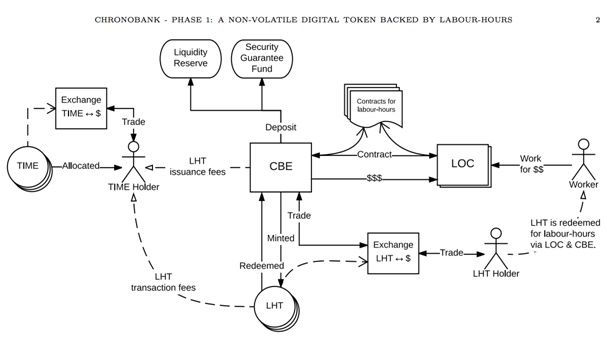
According to the Chronobank vision, the main motivation for companies is the borrowing of funds in the form of currency that the company receives immediately, while the work of their employees can be provided later (and so they can pay employees later also).
Business development and motivation
I immediately noticed one major risk, which is typical of many Blockchain projects that are emerging. It is necessary to separate the parts of the general problem that can be solved with the help of Blockchain technology, and those parts of the tasks that need to be addressed in the field of relationships with government and business. In this case, addressed to many countries and many large business organizations. It is important to understand that the main task of Chronobank lies in both these areas, but not in the production of tokens and the development of this technology.
But the level of research of building relationships with new companies and the likelihood of their participation in the project is very low. What is the benefit of participating in this system, except the lower taxes and the substitution of state regulation for regulation by Chronobank’s structure?
Here is the list of requirements to the companies that will guarantee the performance of work on each token:
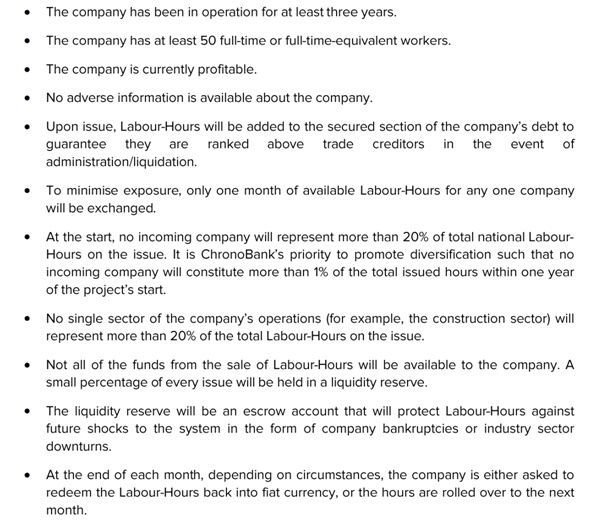
The Chronobank team should have answered the following questions: How many resources and what price will be spent to verify the compliance with these requirements of companies offering the labor? Is this process legal and acceptable for businesses?
The only company currently ready to participate in the issuance of tokens is
Edway Group Ltd, a partner-investor project. Obviously, the partner company (parent company) is ready to help, but it is not enough, if such companies have no motivation other than a conditional loan with low interest. This creates a risk that Chronobank won’t find a new partner in next few years, but to stabilize the price of tokens it is very important to have a large number of partner companies, distributed geographically and economically (see the price volatility below).
Another problem whose solution I couldn’t find - where will the extra value (that the company supplying the labor earns) come from when one company pays with tokens to another company? If tokens strictly correspond to the price of the working time (which is the main advantage declared of these tokens), when one company hires workers from another company, for example for the construction of buildings, and pays with tokens with the price of the average hourly wage. Will the Labour-offering company earn anything? This question requires further study.
An important section of the business development that was left unexplained - there is no description of a mechanism for legal cooperation between Chronobank and the Labour-offering company. If the company doesn’t fulfill their obligations on working hours, how would this issue be solved? The lack of legislative regulation of the Blockchain industry does not establish clear accountability mechanisms between companies and Chronobank.
In the case when obligations are not fulfilled, Chronobank offers to use the reserve fund, but there are no appropriate calculations in case the company refuses to comply with the obligations.
Another risk is how to scale up the project? The workers available at the launch are specific to Australia (the project’s starting place). While, IMHO, in the US and Europe this market is developed significantly worse, and there are no statistics or calculations provided by Chronobank on the volume/number of Labour-offering companies around the world. Thus, it becomes difficult to rate the amount of possible growth even with a successful strategy to attract partners.
It is important to distinguish between Labour-offering companies and ordinary companies that hire labor directly rather than through intermediaries. The vast majority of the planet's employees are employed and working in the same company, building a career, etc. Freelancers and "labor for rent" are less popular.
LHT price volatility
The cornerstone of the Chronobank project is a LH-tokens, which are tied to the average hourly wage in the country and are based on real supply of labor at the large companies hiring workers. ”Because they are backed by real labour, they are absolutely inflation-proof and have next to zero volatility – in comparison to bitcoin and other cryptocurrencies. "
However, here I see a substitution of concepts - labor gets cheaper or more expensive for various reasons, for example due to changes in the value of the national currency or because of the increased volume of migrants. And if the real hour of the builder is not subject to inflation and volatility, any of its assessment, expressed in a particular currency, will inevitably be exposed to one or another. The fact is, that if paying to the employee at the moment when tokens are issued (or at the time of signing of the agreement) all the subsequent volatility falls on the shoulders of the company that had issued the token and agreed to fulfill this work.
"The price of LH tokens in fiat currencies is stable, which allows users to use them in transactions, keeping in touch with the cost in the AUD / USD / EUR / GBP." A small note: Unfortunately, you cannot just assign token to something and say – “now it is one and the same, thus, it is stable. The price of any asset is formed by supply and demand, and the price of LH tokens will be stable only if the token always receives the appropriate amount of labor or real money.
In addition to the idea of using the reserve fund from the crowdsale to finance price stabilization, which itself is a bad practice, no financial calculations - how exactly will the price be stabilized - are provided.

* If no one wants to buy - buy yourself at non-market prices, if nobody wants to sell – sell yourself at non-market prices ‘
Let me explain in detail why this is important and why it will be very difficult to stabilize such a token, even after announcing a linking of the one hour cost to the token. Price has always been regulated by the exchange (or an open market).
As I said, you cannot make the price of something be stable, except by, exaggerating an eternally open order to Buy that same something for 101 and place the same eternal Sell orders for 100. This way you will always be able to keep the price of the goods in the corridor of 100 to 101. So, in order to maintain a stability of the LBH token price, initially Chronobank will use the funds from the crowdsale, the so-called Liquidity Reserve.

I appreciate such a realization of "a stable LHT token" is extremely risky for the participants of the crowdsale, as funds in the Liquidity Reserve can end very quickly. The market impact of these mechanisms is ineffective.
The fact is, that even if a certain company exchanges the time of their employees for the token, it won’t change the volatility of the national currency, which is used to measure wages. The only thing that changes is that this volatility remains on the shoulders of this "labor of the borrower," because he then pays money to the worker but with a different price, adjusted for inflation and exchange rate. Or, if he pays in advance - the volatility problems lies on the shoulders of the employee – and he (for example) does the same work for less money. An hour of work may remain a stable currency only as long as it is owned and managed by the employee himself.
Marketing isn't an economy
When we take a look from the side, we can notice that the main powers of Chronobank team are thrown at marketing, which is a bad factor for company. Very often we see that Chronobank’s marketing strategy mentions that they are changing the industry of HR/Recruitment/Finance, just like Uber changed the taxi. They use all promotion channels - Facebook, Instagram, thematic forums, contextual advertising, etc. However, when someone values a Blockchain-startup in the comparison with Uber, or uses phrases like "total experience of 100 years" instead of a detailed description of the technology and calculations – this is a negative sign for the investor.
They say:
“ChronoBank will use major and well-established recruitment/HR/labour-hire companies that have an immaculate reputation to back the coins”
But where are the research and calculations of how many Companies are required to maintain token price stability? How is the team going to enable cooperation with these companies?
The description of US (and world) economic problems in the Whitepaper is very entertaining, but the proposed solutions with the help of Chronobank’s product is so utopian that requires a consolidated effort of not even large companies, but whole countries (that, obviously, won’t evaluate the introduction of additional currency as profitable).
Tech point
"LH tokens and the distributed Chronobank.io application will be created on the bases of Ethereum, Waves and NEM blockchains,” they say. But there is no specification of how they will ensure the integrity of the system and the price of a single token on different blockchains. The technical study is very crude.
“ChronoBank will issue tokens on all major blockchains, depending on market demand from users and the development of new blockchain platforms. Thus ChronoBank will never become obsolete on the grounds that all tokens were issued on a blockchain that falls from favour. The preliminary list of supported blockchains includes Ethereum/ETC, Waves, NEM and Bitcoin itself.”
And again we see that there are no clear explanation of how this will be implemented under a single contract or system? It's not a secret that in order to combine Ethereum and Bitcoin, the most advanced development teams are making a great effort right now. The mechanism of how this would be implemented by the team of Chronobank is missing in its documents. But if all this framework of different blockchains will be implemented under a (manual) control of Chronobank, it imposes additional risks to investors and users of the system.
Reputation mechanism
The reputational mechanism as a major shift from the base price for work-hours is not developed enough. In fact, it is very complicated and gets regulated by a real market from a number of factors, with each specific employee. The proposed simplification has some serious drawbacks:
“This is solved by a reputation system that will be implemented in LaborX exchange, where reputation is the prominent factor in determining how much a worker can charge.”
"The better the individual's reputation based on previous work, the higher the price they will be able to command for an hour's work. "
Obviously, the digital parameter called "reputation" and engagement of all employees under the average rate in the country leads to considerable abuse by the employer, as well as Chronobank’s attempts to regulate wages price. It turns out that the worker himself can not set a price for the payment of his work, when it will be "tokenized", and will be obliged to be satisfied with the average wage rate in the country. This can be advantageous only to ineffective poor workers. This fact isn’t studied enough and is unlikely to be implemented in practice.
The team
Unfortunately, I have no reasons to believe that the project team will cope with this task - it is incredibly big and serious, but the background of the team does not include projects with a commensurate scale, or even information about participation in such projects.
The team description is made lightly, for example, Sergei Sergienko "represented Australia at the G20 summits and understands how to combine the real and crypto-economy." Australia at the summits is usually represented by president or a prime minister. For example, in 2016 in China, by Malcolm Turnbull, the Australian Prime Minister. He also represented Australia in Turkey in 2015. Such careless description of the project leaders can speak about the absence of real progress in the business.
Another troubling point - one of the founders of Chronobank is a co-founder of an Australian Labour Offering Company, the main partner of Chronobank from the real world. Therefore, we should not valuate
Edway Group Ltd as a major partner company from the outside. It's a real founder of the project, and (probably) the main source of pre-crowdsale-financing.
Expenses details
It is necessary to have a detailed expenditure of funds raised when undertaking such a serious project with a huge amount of investment required. $7,880,000 is a significant sum but the disbursement process is described only as a list of targets.
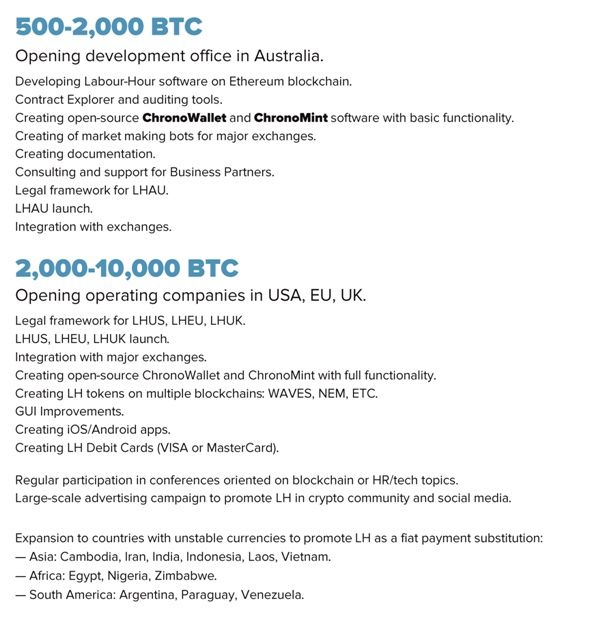
It is also unclear why only after reaching the mark of $ 7.88 million a LabourX market is being developed.
There are no system plans for the implementation of the "revolution of wages" as explained to investors. In fact, a plan for solving problems and spending money is the main criterion of projects quality valuation.
Centralization and possibilities for abuse
One of the main risks of investing in Chronobank – it is ambitious and centralized. They state that with the implementation of at least some of their plans, according to the calculations of the project team itself, Chronobank will become the global "Fed", with the same possibilities to influence major companies. In fact, it means the control of all the wage funds of the largest companies in the developed countries hangs in the oneplace, with the ability of freezing of the funds, ability to produce their currency, regulation of a large number of critical parameters – it is quite difficult to imagine in the real world.
Well, the main red beacon to any qualified Blockchain investor is the phrase: “The liquidity reserve is an offline LHT storage fund controlled by the CBE.” This means that first the funds from the crowdsale and then the whole pieces of the wage funds of large companies (with the described model it is a large sum of money) will be controlled not by a smart contract but a Chronobank team manually.
As a result, Chronobank suggests a very strong centralization and trust of huge resources to them alone. Which is far beyond the ideas about the qualitative distribution of projects in the Blockchain.
The main complexity of realization
The main problem of "decentralized job search that doesn’t require the traditional financial institutions" (which is one of the goals of the project) is that the government has protected the weak (workers) from the strong (employers) with help of different mechanisms for centuries. Because employers have more money and resources, they are smarter. The contracts, benefits, and etc. are primarily invented to protect citizens from unscrupulous employers.
Transactions directly between the business and ordinary people, usually put those people in a very risky position. People don’t like doing it. Usually only a small percentage of online freelancers can afford this type of employment. Consequently, a system like LabourX that has a wage payments for tokens will become popular no sooner than the regulation of the Blockchain technology will be clarified.
It is unclear how different governments would react to the difficulties of charging w taxes in the case of the transition to wage payments with such a token. Legal problems of the project are ten times harder than the ones that Uber has, while most of Uber’s problems are caused by disturbances such as arson of cars and riots.
However, the authors of the project haven’t provided any study of this question, in specific how would "the revolution in labor relations" affect the workers and the unions that are representing their interests, or how would regulators inevitably losing taxes respond.
Unfortunately, there are no fundamental researches of the necessity to use a currency linked to the working time. All of the examples given by Chronobank in the Business Outline are from the past or from closed economic systems, such as small-town farms. There is not a single word about the globalization mentioned, and, in this sense, the linking of the working time to the currency - is a step into the past, not into the future.
Crowdsale dynamics
The ICO started very quickly - about $2,050,000 was collected in the first day, which is very, very solid. Typically, such a dynamic fundraising project fulfills all the goals and gains the necessary amount.
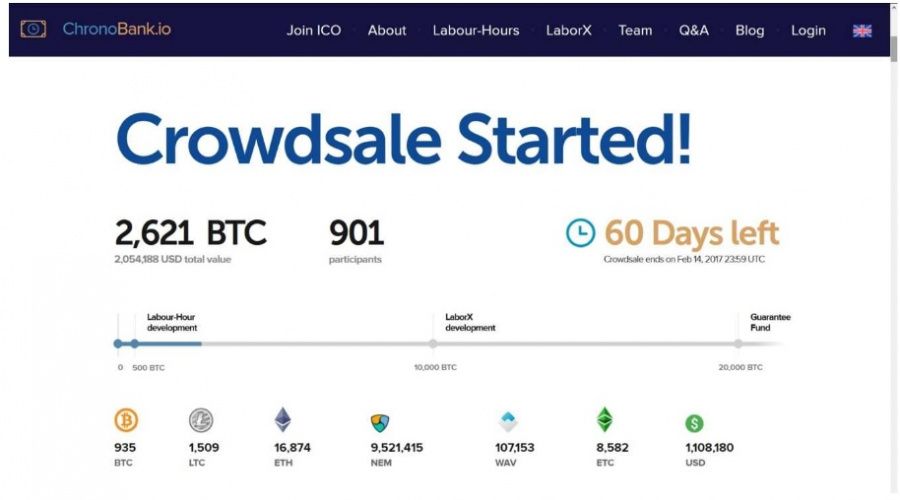
However, in next four days they collected only $140,000.

Such dynamics may mean that large investors were waiting for the project, invested, and there is no need to wait for such investments, which is very bad factor for the remaining small investors.
We can’t check and verify all of the numbers. In contrast to the classic venture investment the ICO investors do not conduct such thorough audits of funding sources. Consequently, there may be abuse by the organizers of the project and manipulation with the numbers provided, in order to collect more money.
The dynamics of this crowdsale, as opposed to a uniform growth of funds raised, is an additional sign of risk for the average investor. Considering the growth of the Bitcoin price lately the amount of funds raised is now bigger, but the dynamics of the crowdsale remained unchanged.
ICO-Marketing
The main reason that I personally did not invest in the Chronobank project – I see it being very far from realization and very utopian, even in spite of a good marketing platform, advertising on all the social networks and elsewhere.
We have, unfortunately, entered into the era of ICO-marketing, that have no real project and a step-by-step working plan for implementation. This is a downside of the emerging beautiful mechanism of Blockchain based investments. Therefore, it is better to leave the decision of making such an investment to the professionals.
Price
Price
News
Price
Price

(0 comments)